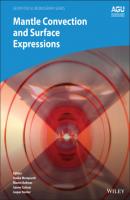Mantle Convection and Surface Expressions. Группа авторов
Чтение книги онлайн.

Читать онлайн книгу Mantle Convection and Surface Expressions - Группа авторов страница 62
Название: Mantle Convection and Surface Expressions
Автор: Группа авторов
Издательство: John Wiley & Sons Limited
Жанр: Физика
isbn: 9781119528593
isbn:
While the maps shown in Figure 3.8 illustrate the temperature dependence of P‐ and S‐wave velocity deviations from PREM, they heavily rely on assumptions about the Fe3+/∑Fe ratio in bridgmanite and about Fe‐Mg exchange between mineral phases. To explore the impact of these compositional parameters on computed P‐ and S‐wave velocities, I varied the Fe3+/∑Fe ratio of bridgmanite and the Fe‐Mg exchange coefficients between bridgmanite and ferropericlase in pyrolite and harzburgite and between bridgmanite and the CF phase in metabasalt within the ranges suggested by data plotted in Figures 3.6a and 3.6b. When varying one compositional parameter, all other parameters were fixed to their values in the references scenarios. Figure 3.9 shows the resulting deviations of P‐ and S‐wave velocities from PREM assuming a range of Fe3+/∑Fe ratios in bridgmanite or different Fe‐Mg exchange coefficients for each bulk rock composition along the central adiabats shown in Figure 3.8. Computed P‐ and S‐wave velocities of both pyrolite and harzburgite are more sensitive to changes in the Fe‐Mg exchange coefficient between bridgmanite and ferropericlase than to changes in the Fe3+/∑Fe ratio of bridgmanite. The sensitivity to Fe‐Mg exchange increases with depth, in particular for S waves. When combined with a reduction of the Fe‐Mg exchange coefficient
Figure 3.9 Relative contrasts between modeled P-wave (upper row) and S-wave (lower row) velocities for pyrolitic (left column), harzburgitic (central column), and basaltic (right column) bulk rock compositions and PREM along adiabatic compression paths starting at 1900 K and 25 GPa (see Figure 3.8). Variations in the Fe3+/∑Fe ratio of bridgmanite and in the Fe‐Mg exchange coefficient have been explored for each bulk rock composition as indicated below the respective diagrams. Dashed curves show P‐ and S‐wave velocity contrasts when the effect of different continuous phase transitions on elastic properties is ignored or modified as specified. Red shaded bands indicate the differences in modeled P‐ and S‐wave velocity contrasts that result from combining the elastic properties of mineral phases and compositions according to either the Voigt or the Reuss bound.
The Fe3+/∑Fe ratio of bridgmanite dictates the whole‐rock Fe3+/∑Fe ratio and, for pyrolite and harzburgite, appears to affect velocity gradients dv/dz with higher Fe3+/∑Fe ratios leading to steeper gradients dv/dz. Again, the effect seems to be strongest for S waves. Based on a comparison of computed P‐ and S‐wave velocity gradients of pyrolite with PREM, Kurnosov et al. (2017) argued for a reduction of the ferric iron content in bridgmanite with depth. While a steepening of velocity gradients with higher Fe3+/∑Fe ratios of bridgmanite is consistent with the modeling results presented here, an actual match of a pyrolitic bulk composition with PREM seems only possible for S‐wave velocities and at depths in excess of 1500 km. Assuming a Fe‐Mg exchange coefficient of